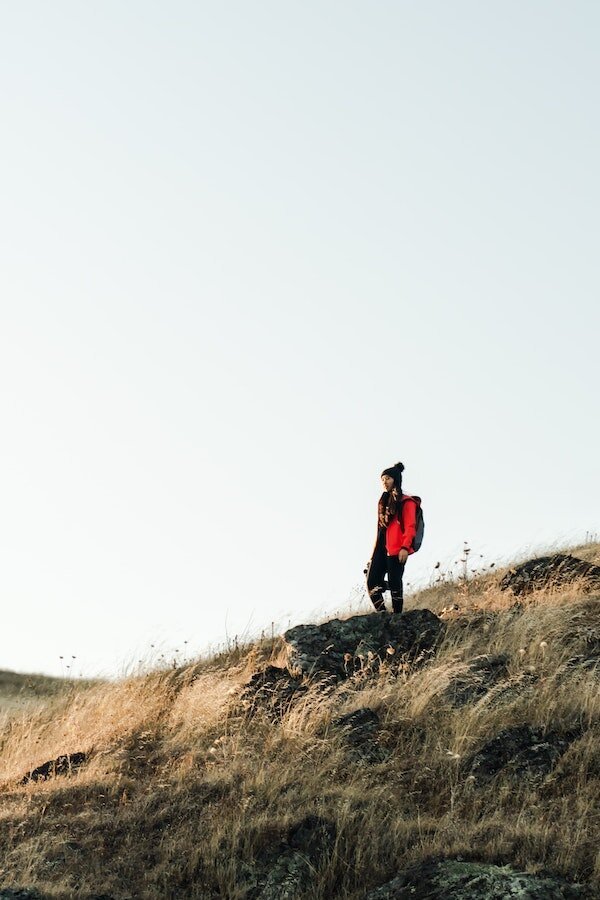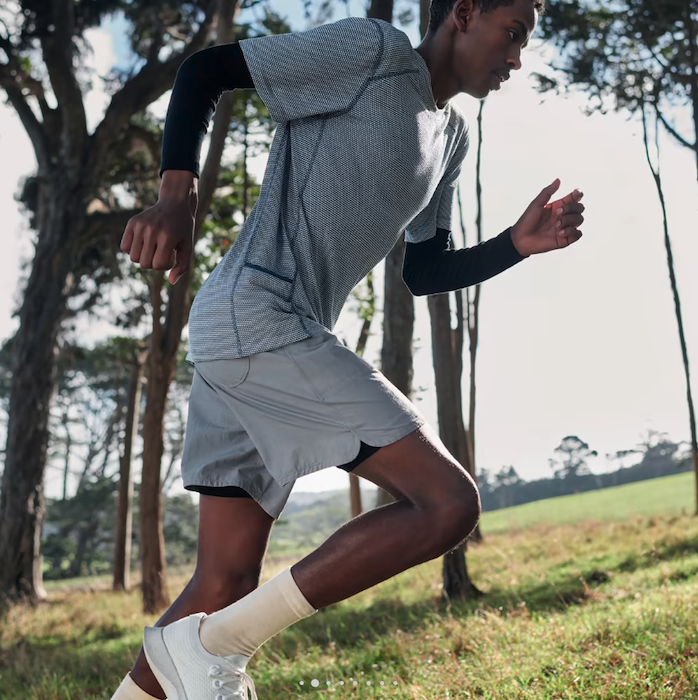
How To Hike Alone: An Approachable Guide To Going Solo Outdoors
Advice For The Solo Hiker
Cold air bites at my cheeks, turning them crimson—though the shade doesn’t rival the sunrise up ahead. It’s going to be a hot one, I think, pausing for a moment to check that I’ve brought enough water. We’re good. I trudge onward, making my way into the forest.
Mornings are my favorite time to start a hike: The light is soft as it filters through the trees and wakes the wildflowers. Aside from the birds and the sound of my boots crunching dirt, the forest is quiet, not yet awake for the new day.
On the trails, I get to leave my city life behind. The mountains don’t care if I’m wearing makeup or if I’ve washed my hair. Out here, I get to shed it all—expectations, worries, and to-do lists. My focus is only on taking another step, on paying attention to the nature around me.
“The mountains don’t care if I’m wearing makeup or if I’ve washed my hair. Out here, I get to shed it all—expectations, worries, and to-do lists.”
“I love that nature brings such clarity and peacefulness,” says Sol, a hiker and Instagrammer from Washington. “I can truly be in the present moment outdoors because time just slows down.” Sol completed her first solo summit in 2017. And this year, she’s aiming to hike once per week as part of the 52 Hikes Challenge.
Like Sol, I also love hiking alone; there’s something sacred and calming about spending a day in the mountains by yourself. “I’ve had some of my best self reflections out there,” says Sol. Time alone in nature allows you to meditate and process your thoughts and emotions.
Hiking can be equally light-hearted too. Nature reminds us to have fun and engage with the world as our playground. A day in the woods can reignite wonder and imagination; it can also be a great time to catch up on audiobooks or podcasts, if that’s your style.
While I’m no expert mountaineer, I’ve picked up a few tips and tricks for hiking along the way. Sol has offered a few of her own, too. Because, while hiking can be a wonderful and healing experience, it’s also necessary to practice safety—and sustainability.
“While hiking can be a wonderful and healing experience, it’s also necessary to practice safety—and sustainability.”
Plus, hiking alone can feel awkward, especially at first. There are many unknowns and fears that come with frolicking alone in the woods, and appearing lonely to other hikers is just one of them. (Just me? Oh no.)
But those fears don’t have to stop us. Ready to lace up your boots and hit the trails? Here’s how to go at it alone:
Where To Go
If you’re new to hiking, I recommend starting small. As romantic as it may sound to “get lost in the woods,” it’s risky to go off into the wild without a plan or experience.
Search online for trails in your city—nature walks, parks, and local trails are perfect for getting acquainted with the sport (and breaking in your boots). Shorter trails will likely have many other people, too, which can make the experience a bit less daunting. There’s no shame in asking for help or directions if you need them. I’ve always found hikers to be some of the friendliest people—something about fresh air brings out the best in others.
“Shorter trails will likely have many other people, too, which can make the experience a bit less daunting.”
But if you’d prefer to rely on digital help, the AllTrails app lets you search by mileage, popularity, distance, and even whether or not a trail is dog-friendly. You can also log your hikes and bookmark future ones. It’s my favorite tool for discovering the best (or lesser-known) trails rated by hikers in your city. I also love it for real-time updates about weather closures and trail conditions.
“Read trip reports!” emphasizes Sol, who also uses AllTrails, the Washington Trail Association, and Instagram for finding new hikes. “I honestly love reading them because they give me a better understanding of how a trail currently looks.”
What To Bring
When I first started hiking, especially when I only hiked local and shorter distance trails, I rarely brought anything more than my water bottle and cell phone—don’t follow my lead. You can never be too prepared when it comes to nature.
“I bring a lot of snacks which can fill up my pack quick,” says Sol, who also carries gear from American Hiking Society’s Ten Essentials list. These items include a map and compass, water and snacks, sunscreen, and a first aid kit, among other recommended essentials.
“You can never be too prepared when it comes to nature.”
Today, I never hike without a whistle, a pocket knife, a mini first aid kit, my GPS watch, granola bars, and a lightweight jacket. I also always bring chapstick. (What is it about chapstick that you always need it most when you don’t have it?)
Additionally, if you’ll be hiking all day, consider carrying a GO anywhere toilet kit and a Tushy travel bidet (it’s a keychain!) to pack up your waste.
Safety Tips
-
Always tell someone where you’re going. I hike with my cell phone, and I share my location with my partner (and my mom, let’s be honest) once I’ve reached the trailhead. I text them the trail name, mileage, and when I expect to be back. I also turn my location services on. While service is limited in the mountains, it’s best to take all precautions if someone does need to track your device.
-
Check the weather. Check it before you leave, and then recheck it at the trailhead (or in the nearest city with cell service). If you’re in a national park, you can ask rangers as well. In the mountains, sudden storms are common and can be dangerous for hikers.
-
Start your hike early in the day. This tip is as much for sun protection as it is to give yourself a time cushion. Even if you only plan to hike a few miles, start early in the day. The weather is cooler and, if you happen to miss a turn and log an extra mile or two, you still have plenty of daylight to retrace your steps.
-
Bring a compass/GPS—even if it’s the most straightforward trail in the world.
-
Carry personal safety equipment just in case. Because we’re all thinking it, right? What happens if we come across an unsavory person or animal in the woods? While I would hope this never happens, it’s best to be prepared. This can also make you feel safer so you can focus on what you’re there to do: hike! Consider carrying mace and a safety alarm—both items are small, and the latter can scare away animals as well as alert other hikers that you need help. I also carry bear spray for back-country hiking (learn how to use it safely here).
For more safety tips, check out the National Park Service website.
Social & Environmental Responsibility
Outdoor spaces are for everyone, but it doesn’t always seem that way. There is a perpetuated narrative in hiking (white, thin, non-disabled), and outdoor brands and organizations have historically upheld this stereotype. Only recently are we beginning to see representation in hiking, despite it having always been there.
“Only recently are we beginning to see representation in hiking, despite it having always been there.”
“According to a 2016 poll by New America Media’s Next 100 Coalition…seventy percent of those surveyed, all people of color, said they regularly participate in outdoor activities, including hiking, camping, photography, and picnicking,” writes Latria Graham an Outdoor Magazine op-ed, titled We’re Here. You Just Don’t See Us.
“Many people talk about the importance of representation in the outdoors, but that’s all it is—talk,” says Sol. When she didn’t see any bald women in outdoor spaces a few years ago, she became that representation for herself. “Be the representation you wanna see. Amplify those who you don’t normally see in these spaces, especially darker skinned people. Use the privileges you have to help make the outdoors more accessible for Black, Indigenous, and people of color.”
Additionally, it’s essential we respect the land we’re hiking on, through sustainable practices and leave no trace principles. But we can also learn about Indigenous land recognition. This begins with education, self-reflection, and a shift in language, according to the Native Governance Center. Instead of talking about Indigenous land as if it’s part of our past, we can acknowledge the people who still live there and who the land still belongs to. We can also research the correct names for trails and mountains we are hiking. Sol recommends using Native Land, an app created by Indigenous Peoples.
“Instead of talking about Indigenous land as if it’s part of our past, we can acknowledge the people who still live there and who the land still belongs to.”
“Land acknowledgments are an important first step in rectifying past harms, but also in increasing awareness of vital Indigenous land management practices that make the many trails we love better for all,” writes Lydia Jennings in Trail Runner Magazine.
“Knowing what a trail or mountain is called by the original land stewards in their languages is a prism into how those caretakers see the world, how this place came to be, and why we must continue to care for these ecosystems.”
Ready to go on your next adventure? Me too! As the weather warms, I hope we all can find time and space to get outside and explore our nearest trails—whether alone or with loved ones. Happy hiking!
Do you have tips and tricks for hiking alone? I’d love to hear them in the comments below!
Kayti Christian (she/her) is a Senior Editor at The Good Trade. She has a Master’s in Nonfiction Writing from the University of London and is the creator of Feelings Not Aside, a newsletter for sensitive people.
RELATED READING





